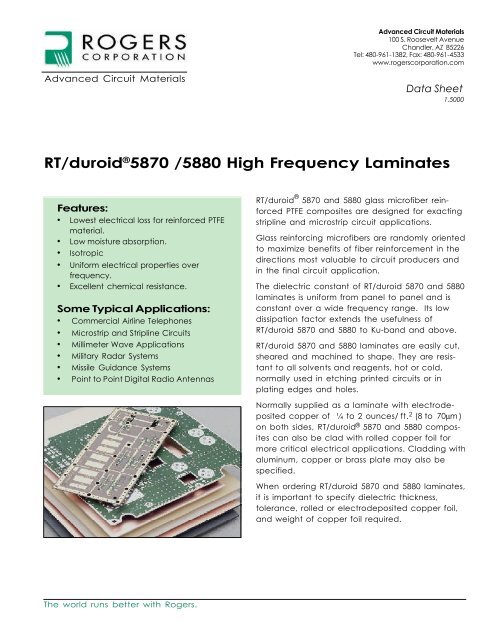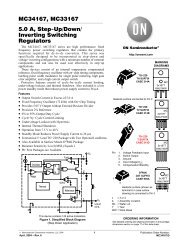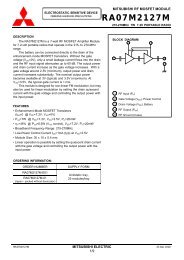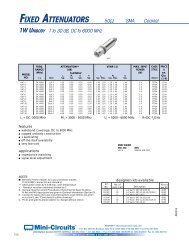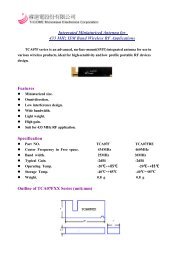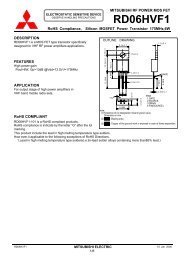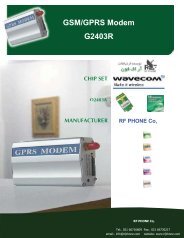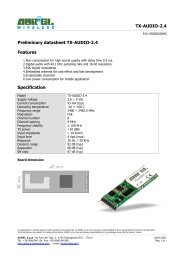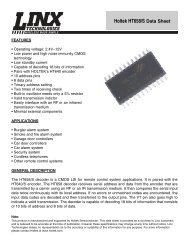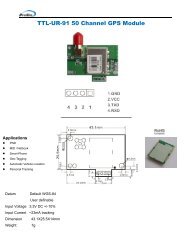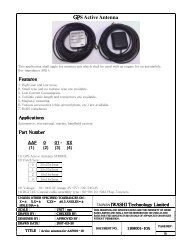RT/duroid ® 5880
RT/duroid ® 5880
RT/duroid ® 5880
You also want an ePaper? Increase the reach of your titles
YUMPU automatically turns print PDFs into web optimized ePapers that Google loves.
Advanced Circuit Materials<br />
100 S. Roosevelt Avenue<br />
Chandler, AZ 85226<br />
Tel: 480-961-1382, Fax: 480-961-4533<br />
www.rogerscorporation.com<br />
Advanced Circuit Materials<br />
Data Sheet<br />
1.5000<br />
<strong>RT</strong>/<strong>duroid</strong> ® 5870 /<strong>5880</strong> High Frequency Laminates<br />
Features:<br />
• Lowest electrical loss for reinforced PTFE<br />
material.<br />
• Low moisture absorption.<br />
• Isotropic<br />
• Uniform electrical properties over<br />
frequency.<br />
• Excellent chemical resistance.<br />
Some Typical Applications:<br />
• Commercial Airline Telephones<br />
• Microstrip and Stripline Circuits<br />
• Millimeter Wave Applications<br />
• Military Radar Systems<br />
• Missile Guidance Systems<br />
• Point to Point Digital Radio Antennas<br />
<strong>RT</strong>/<strong>duroid</strong> ® 5870 and <strong>5880</strong> glass microfiber reinforced<br />
PTFE composites are designed for exacting<br />
stripline and microstrip circuit applications.<br />
Glass reinforcing microfibers are randomly oriented<br />
to maximize benefits of fiber reinforcement in the<br />
directions most valuable to circuit producers and<br />
in the final circuit application.<br />
The dielectric constant of <strong>RT</strong>/<strong>duroid</strong> 5870 and <strong>5880</strong><br />
laminates is uniform from panel to panel and is<br />
constant over a wide frequency range. Its low<br />
dissipation factor extends the usefulness of<br />
<strong>RT</strong>/<strong>duroid</strong> 5870 and <strong>5880</strong> to Ku-band and above.<br />
<strong>RT</strong>/<strong>duroid</strong> 5870 and <strong>5880</strong> laminates are easily cut,<br />
sheared and machined to shape. They are resistant<br />
to all solvents and reagents, hot or cold,<br />
normally used in etching printed circuits or in<br />
plating edges and holes.<br />
Normally supplied as a laminate with electrodeposited<br />
copper of ¼ to 2 ounces/ ft. 2 (8 to 70µm)<br />
on both sides, <strong>RT</strong>/<strong>duroid</strong> ® 5870 and <strong>5880</strong> composites<br />
can also be clad with rolled copper foil for<br />
more critical electrical applications. Cladding with<br />
aluminum, copper or brass plate may also be<br />
specified.<br />
When ordering <strong>RT</strong>/<strong>duroid</strong> 5870 and <strong>5880</strong> laminates,<br />
it is important to specify dielectric thickness,<br />
tolerance, rolled or electrodeposited copper foil,<br />
and weight of copper foil required.<br />
The world runs better with Rogers.
PROPE<strong>RT</strong>Y TYPICAL VALUE DIRECTION UNITS CONDITION TEST METHOD<br />
Dielectric Constant, e r<br />
2.35<br />
2.33 ± 0.02 spec.<br />
Dissipation Factor, tan d 0.0005<br />
0.0012<br />
<strong>RT</strong>/<strong>duroid</strong> ® 5870 <strong>RT</strong>/<strong>duroid</strong> ® <strong>5880</strong><br />
2.20<br />
2.20 ± 0.02 spec.<br />
0.0004<br />
0.0009<br />
Z<br />
Z ---<br />
Z<br />
Z<br />
C24/23/50<br />
C24/23/50<br />
--- C24/23/50<br />
C24/23/50<br />
1 MHz IPC-TM-650 2.5.5.3<br />
10 GHz IPC-TM-650 2.5.5.5<br />
1 MHz IPC-TM-650 2.5.5.3<br />
10 GHz IPC-TM-650 2.5.5.5<br />
Thermal Coefficient of e r<br />
-115 -125 ppm/°C -50 - 150°C IPC-TM-650 2.5.5.5<br />
Volume Resistivity 2 X 10 7<br />
2 X 10 7<br />
Z Mohm•cm C96/35/90 ASTM D257<br />
Surface Resistivity 3 X 10 8 3 X 10 8 Z Mohm C96/35/90 ASTM D257<br />
Tensile Modulus<br />
Test at<br />
23°C<br />
1300(189)<br />
1280(185)<br />
ultimate stress 50 (7.3)<br />
42 (6.1)<br />
Test at<br />
100°C<br />
490 (71)<br />
430 (63)<br />
34 (4.8)<br />
34 (4.8)<br />
Test at<br />
23°C<br />
1070 (156)<br />
860 (125)<br />
29 (4.2)<br />
27 (3.9)<br />
Test at<br />
100°C<br />
450 (65)<br />
380 (55)<br />
20 (2.9)<br />
18 (2.6)<br />
X<br />
Y<br />
X<br />
Y<br />
MPa (kpsi)<br />
MPa (kpsi)<br />
A<br />
ASTM D638<br />
ultimate strain 9.8<br />
9.8<br />
Compressive Modulus 1210 (176)<br />
1360 (198)<br />
803 (120)<br />
ultimate stress 30 (4.4)<br />
37 (5.3)<br />
54 (7.8)<br />
ultimate strain 4.0<br />
3.3<br />
8.7<br />
[1] SI unit given first with other frequently used units in parentheses.<br />
[2] References: Internal TR’s 1430, 2224, 2854. Test were at 23°C unless otherwise noted.<br />
Typical values should not be used for specification limits.<br />
8.7<br />
8.6<br />
680 (99)<br />
860 (125)<br />
520 (76)<br />
23 (3.4)<br />
25 (3.7)<br />
37 (5.3)<br />
4.3<br />
3.3<br />
8.5<br />
6.0<br />
4.9<br />
710 (103)<br />
710 (103)<br />
940 (136)<br />
27(3.9)<br />
28 (5.3)<br />
52 (7.5)<br />
8.5<br />
7.7<br />
12.5<br />
7.2<br />
5.8<br />
500 (73)<br />
500 (73)<br />
670 (97)<br />
22 (3.2)<br />
21 (3.1)<br />
43 (6.3)<br />
X<br />
Y<br />
X<br />
Y<br />
Z<br />
X<br />
Y<br />
Z<br />
%<br />
MPa (kpsi)<br />
MPa (kpsi)<br />
Deformation Under Load Test at 150°C<br />
1.0 Z % 24 hr/14 MPa (2kpsi)<br />
Heat Distortion<br />
Temperature<br />
8.4<br />
7.8<br />
17.6<br />
X<br />
Y<br />
Z<br />
%<br />
A<br />
ASTM D695<br />
ASTM D621<br />
>260 (>500) >260 (>500) X,Y °C (°F) 1.82 MPa (264 psi) ASTM D648<br />
Specific Heat 0.96 (0.23) 0.96 (0.23) J/g/K<br />
(BTU/lb/°F)<br />
Moisture Absorption<br />
Thickness = 0.8 mm<br />
(0.031)<br />
Thickness = 1.6 mm<br />
(0.062)<br />
0.9 (0.02)<br />
13 (0.015)<br />
0.9 (0.02)<br />
13 (0.015)<br />
Calculated<br />
mg (%) D24/23 ASTM D570<br />
Thermal Conductivity 0.22 0.20 Z W/m/K ASTM C518<br />
Thermal Expansion X Y Z X Y Z


